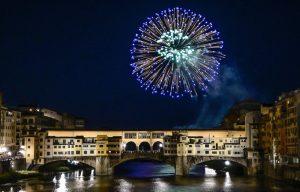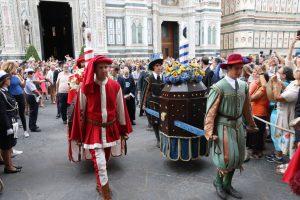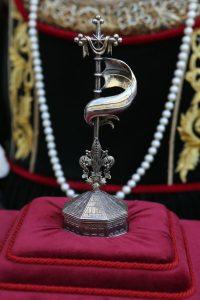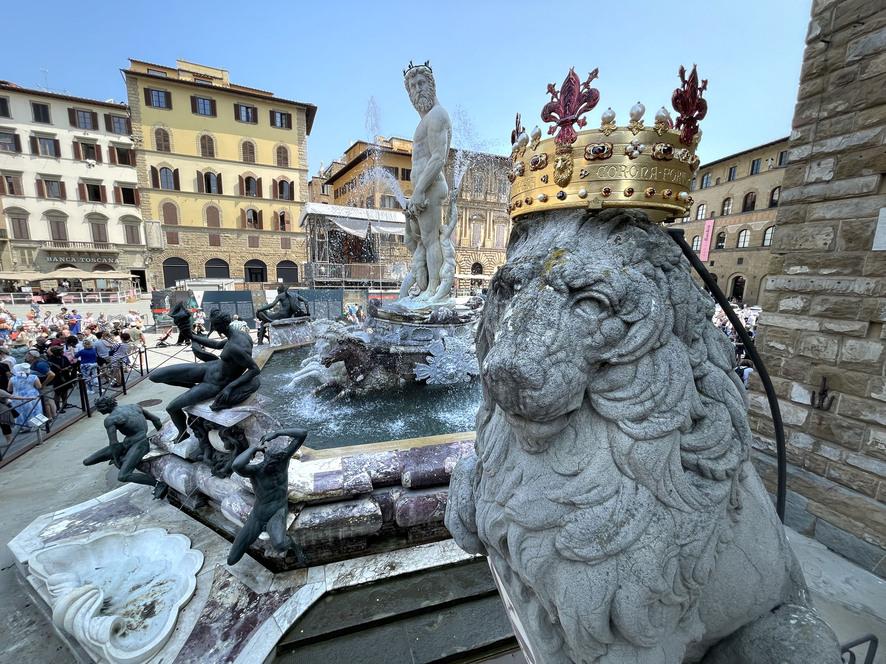By Our Editorial Staff
It was customary for the eve of St. John to celebrate and light bonfires of or brooms in the city, in the squares and in the countryside and on the hills around the city to celebrate the summer solstice. They were the ‘fires of rejoicing’ which, recalling their pagan origins, attributed sacredness to light. Of that ancient pagan heritage, Florence has preserved the tradition of fires, organized today by the Society of St. John the Baptist with the contribution of the CR Firenze Foundation and the collaboration of the Municipality of Florence.

Since 1200, the patron saint’s feasts have acquired solemnity, becoming a manifestation of the power and wealth first of the Municipality and then of the Signoria.
Places designated for fires, with bonfires were Piazza Duomo, between the Baptistery and the Cathedral, above the gates of the city walls and in Piazza Signoria, to give spectacularity pans with tallow were added for the lighting of Palazzo Vecchio, the Bargello, the Cathedral and the Baptistery.
From the thirteenth century, with the discovery of gunpowder, a mixture of saltpeter with charcoal and sulphur, bonfires were replaced, in the tradition, by artificial “Seals”.
 The light produced was mostly monochromatic white, with few reflections, but great progress was made only from the beginning of the 1800s in terms of aesthetic effects, the addition of colours (with red, blue and green), splendour and speed of combustion.
The light produced was mostly monochromatic white, with few reflections, but great progress was made only from the beginning of the 1800s in terms of aesthetic effects, the addition of colours (with red, blue and green), splendour and speed of combustion.
At the beginning in Florence it was a matter of ‘rockets’ that started from Porta alla Croce or Canto alle Rondini.
It was from the late Middle Ages that panels with configurations of images and pinwheels of the fires were used with great spectacularity and later still with panels and pinwheels on the Tower of Palazzo Vecchio.
It will be the return of the Medici and in particular with Cosimo I (first Grand Duke) that great solemnity will be given to the feast of the Patron with the use of some show apparatuses, in various forms, supported in the air with much artifice and full of worked fires, commonly called pinwheels, of different shapes, real works of engineering.
As proof, we would say today, of the value of directing, famous artists such as Tribolo (Niccolò Pericoli 1500-1550), sculptor and architect, distinguished themselves in this regard.
Bernardo Buontalenti (1523-1608) also tried his hand at this feat, showing in Florence the most wonderful fireworks that had ever been seen, so much so that he was nicknamed “Bernardo delle girandole”.
 There have been many representations of painters on fires. A particular testimony can be found in Palazzo Vecchio in the fresco by Giovanni Stradano (1523-1605) which reproduces Piazza della Signoria, paved in terracotta, with the fires ‘shot’ from above the Loggia de’ Lanzi and the bonfires that were lit on the eve of St. John’s Day are also depicted in the square.
There have been many representations of painters on fires. A particular testimony can be found in Palazzo Vecchio in the fresco by Giovanni Stradano (1523-1605) which reproduces Piazza della Signoria, paved in terracotta, with the fires ‘shot’ from above the Loggia de’ Lanzi and the bonfires that were lit on the eve of St. John’s Day are also depicted in the square.
Another depiction of the fires is the nineteenth-century one, from the bridge to the Carraia, by Giovanni Signorini, a pictorial testimony that reminds us of the migration, in 1827, of the show, from Piazza della Signoria, to the bridge to the Carraia cause, in that year, of a fire caused on Palazzo Vecchio, thus offering a more suitable place to welcome the immense crowd that arrived, even from the countryside, to enjoy the popular show.
In 1923, for reasons of safety and wider horizon and visibility, they were transferred to Piazzale Michelangelo where they still take place today for the enjoyment of the citizens and the many tourists present in the city at that time.
The duration of the Fochi is about 35 minutes and most of them are aerial fires, which explode in the sky, falling into different shapes such as stars, snakes, fountains and other elements that draw colourful choreographies.
The preparation work is demanding both in terms of the allocation of the fireworks on the space intended for use in Piazzale Michelangelo with all the safety precautions and requires the use of suitable personnel.
There is no particular tradition linked to colours except for a path that tends to be intensified as the minutes go by in the rapidity of emissions and the very dimensions of the type of aerial fire.
Added to these are the set-ups on the Lungarno della Zecca for the placement of chairs to watch the show and the adoption of the related prevention and safety plans dictated by the regulations in force on the subject.
There are many observation points as well as a very high number of people who follow the event even from the terraces of their homes, as this is a traditional opportunity to meet friends or relatives.
However, it remains a show that attracts and strikes the collective memory, leaving more or less favourable comments at the end… But, of course, there will always be those who will say: “Last year’s fireworks were better!”

What’s in store for the 2024 show?
As tradition dictates, the Fochi will continue to be ‘shot’ from Piazzale Michelangelo following the canonical start time of 10.00 pm. It is in fact at this time that the bang is fired announcing the start of the show and alerting the technicians to turn off the public lighting on the Lungarno della Zecca and in the Oltrarno, from the Tower of San Niccolò to climb along the ramps up to and including the square, for a better enjoyment of the show.
It is customary, before the fireworks display, to hold a musical entertainment on the Lungarno della Zecca from 9.00 p.m. until then until the beginning of the Fochi. This year the concert will be held by the band of the State Police who offer this tribute to the City.

